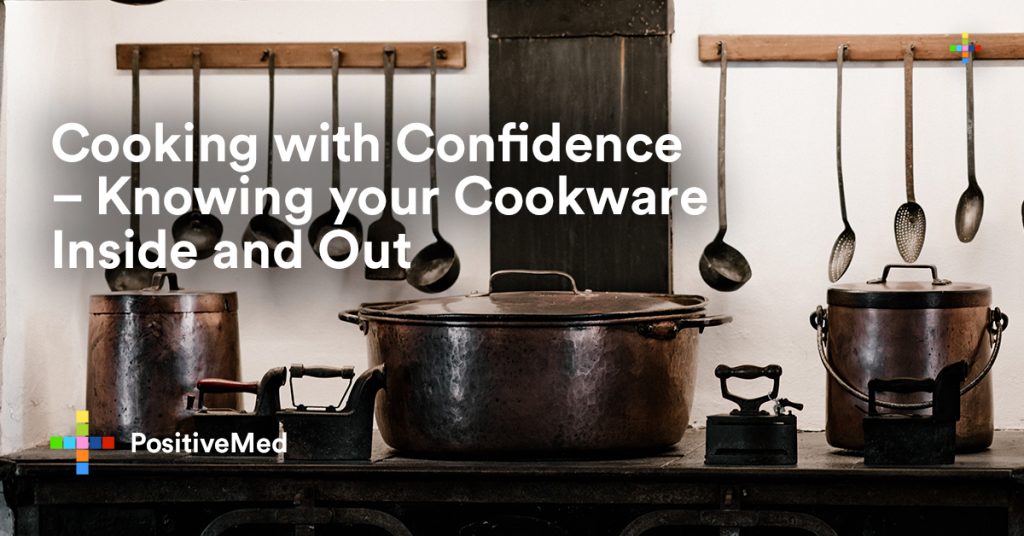Anyone who cooks regularly can tell you, sometimes it can seem like staying safe in the kitchen is a losing battle. Between high-temperature cooktops, sharp implements, and food-borne illnesses, there is any number of pitfalls ready to trip you up when you are cooking for your friends or loved ones (or for yourself!). Whatever cookware you’re using, here are the top health and safety concerns you may face when cooking in the kitchen.

Stainless Steel
Stainless steel cookware is one of the safest types of cookware you could use in the kitchen. Stainless steel is extremely durable, will not corrode or degrade in the face of highly acidic foods, and it can easily be sterilized for maximum food safety.
One small health concern is that stainless steel, especially in higher-end cookware sets, may come with a core or cladding of aluminum, copper, or other metals in the bottom or sides of the pan, to better conduct heat through the cookware. If the stainless steel is worn or scratched away, it is possible that those metals may be exposed. If this happens, dispose of the pan, as there is a potential for these metals to leach into your food.
Aluminum Cookware
Aluminum is a cheap and popular option for durable, easy to use cookware. Aluminum cookware is usually sealed so that the metal cannot leach into food, and it has a similar shiny, hard finish to stainless steel, which makes it easy to clean and sterilize.
On the other hand, uncoated aluminum can be corroded or stripped by very acidic foods, which can lead to trace amounts of aluminum ending up in the food you eat. Studies agree that the trace amounts that end up in your food are not harmful but it can change the color and even flavor of the food you are cooking. If trace metals in your pasta sauce are a concern, you can prevent this by making sure to only use coated aluminum. Although coated and uncoated aluminum can both be put in the dishwasher, hand washing will ensure the surface stays undamaged on coated cookware.
Although scientists have concluded that trace aluminum in your food won’t cause any adverse health effects, the Alzheimer’s Association in the United States has stated that aluminum in your diet may be a risk factor for developing the disease. Studies on this are inconclusive, but you may find that it’s better safe than sorry on this front.
Anodized Aluminum
Anodizing is a process that enhances the naturally occurring layer of aluminum oxide on the surface of aluminum pots and pans, which hardens the surface and makes it non-reactive. Anodizing is practically standard these days for aluminum cookware, as it hardens the surface of aluminum cookware and increases its resistance to corrosion from acidic foods.
Anodized aluminum should be handled similarly to non-stick cookware; the best bet, as with all cookware where maintaining the surface integrity is important, is to handwash your anodized aluminum pots and pans and try to avoid exposing them to harsh chemical cleaners or overly abrasive cleaning products or tools.
Copper Cookware
Copper cookware is highly prized for its thermal properties. Copper has the best thermal conductivity of any metal used to make cookware, leading to fast, even heating of food across the entire surface. Copper also doesn’t store heat, unlike iron or aluminum, which means that as soon as a copper pot or pan is moved away from the heat source, the temperature begins to drop. This means the cook can very precisely control how fast heat enters the food they are preparing, which improves food quality and also reduces the chances of foodborne illness from improperly cooked raw food.
However, copper is also very prone to corrosion, and high levels of copper can lead to copper toxicity, a condition which can lead to paralysis and blindness, among other side effects. Copper leaching happens when highly acidic foods, like tomatoes or anything containing vinegar, strips the surface layer of copper in uncoated pots and pans.
For this reason, most copper cookware is coated, or otherwise, the copper is sandwiched between another metal, such as aluminum or steel. The exceptions are pots and pans manufactured specifically for cooking preserves, such as jam or jelly, and meringues.
Egg whites do not react with the copper, and copper actually encourages the formation of meringue by slightly denaturing the proteins in the egg white, which helps them hold onto each other and form stiff peaks without coagulation. Fruit preserves might be acidic enough to corrode copper if it weren’t for the concentration of sugars, and the addition of even more sugar, which occurs during the cooking of jellies and jams.
To avoid these health concerns, make sure that any copper pots or pans you purchase are coated, or stick with copper cores in other types of cookware, such as steel or aluminum. If the copper core becomes exposed, make sure to get the cookware re-clad, or dispose of it and buy a new piece.
Related Link: The Crazy Cooking Hack that Slashes the Calories in Rice by Half
Ceramic
Ceramic cook and bakeware can include ceramic over another material, such as enameled cast iron or steel, or ceramic on its own, as with baking dishes. Entirely ceramic cookware should never be put on a burner or heating element, as tiny imperfections and air bubbles in the ceramic can cause the cookware to heat unevenly and crack, or even explode.
Ceramic-clad cookware is very popular for its durability, look, and heat-retention properties. Much like cast-iron, ceramic takes on heat slowly and evenly and holds onto it for a long time, making it a popular material for long, slow cooking processes such as roasting or braising.
The only health concern when using ceramic in terms of leaching is that up until the 20th century, glazes used on pottery often contained lead, which could reach out and into the food being consumed. Lead is stored and not excreted by the body, which means that heavy metal poisoning can occur over time even if the exposure is very low. Commercially produced ceramic cookware will not contain lead, but independent artisans may still use glazes containing lead. The best bet with ceramics you intend to cook with is to stick with a well-known brand.
Non stick cookware
When buying nonstick cookware, most of what you see is going to be steel or aluminum coated with PTFE or polytetrafluoroethylene, also known as Teflon. Teflon is a material which prevents foods from sticking and reduces the need for using fat or oil in cooking. However, Teflon coatings can degrade over time, especially when exposed to very high temperatures or harsh industrial cleaners.
To prevent this, make sure to always wash nonstick cookware by hand, using warm water and mild soap. Also avoid using metal implements in nonstick cookware, as this can scratch the coating and cause it to deteriorate faster.
Additionally, never heat an empty nonstick pan. Temperatures as low as 500 degrees Fahrenheit can cause the coating to decompose rapidly, emitting toxic fumes and potentially ruining the coating. Always put your food or cooking oil in the pan before placing it on the heating element. Also, nonstick cookware should never be used in the oven.
Cast Iron
Cast iron is a very popular choice for any chef’s kitchen because of its excellent heat retention. This leads to efficient, even heating over long cooking periods, and when properly seasoned, it is very easy to clean and maintain.
Cast iron may rust if it is left sitting in water, or if the seasoning is improperly applied. If you do notice any rust on your cast iron, don’t worry, as iron oxide is not toxic to humans. It can, however, affect the color and taste of your food, so just scour the rusty spots with steel wool until you cannot see any more discoloration, then wash and dry your pan and re-season it according to manufacturer’s instructions.
A Few Final Thoughts
Cooking can be a perilous enough experience if you know exactly what you’re doing, and even experienced cooks may run into unexpected accidents in the kitchen. However, if you remember these simple health and safety facts, you can at least be confident that you’re getting the most out of your cookware in the safest way possible.
Author Bio:
Meg Davis is a stay at home mom with two kids. She created Simple Green Moms as a resource for sharing healthy recipes, cooking tips, and lifestyle advice with other families.







